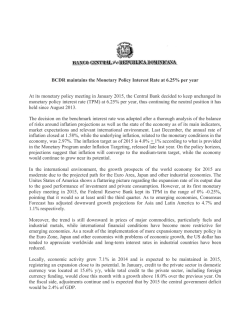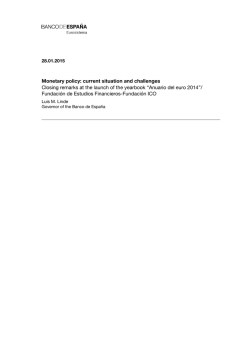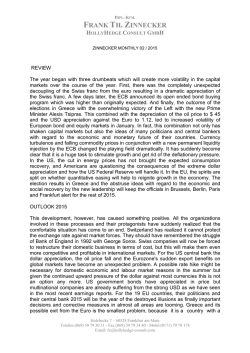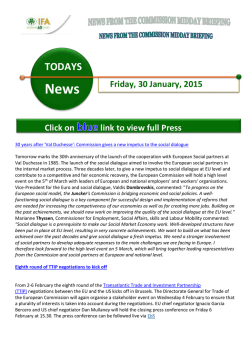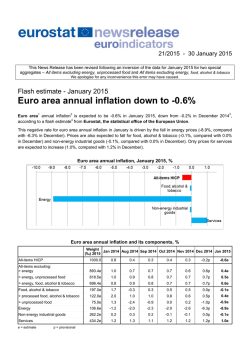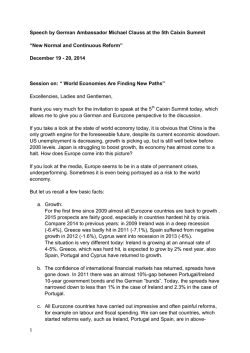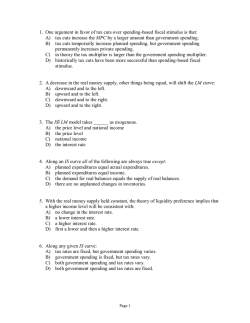
CESEE Research Update Q4/2014 - Oesterreichische Nationalbank
www.oenb.at/cesee-research-update Q4/2014 CESEE Research Update Foreign Research Division www.oenb.at/cesee-research-update Content CEEI 2014 ............................................................... 2 Olga Radzyner Award Winner 2014 ..... 3 Focus on European Economic Integration Q4/14 ............................................. 4 The CESEE Research Update is released quarterly by the Foreign Research Division of the Oesterreichische Nationalbank (OeNB). The aim of this newsletter is to inform readers about OeNB research and analysis output on Central, Eastern and Southeastern Europe (CESEE) as well as past and forthcoming CESEE-related events. OeNB Euro Survey .......................................... 5 Foreign Research Division South-East European Monetary History Network ............................................... 7 OeNB Summary of the 19th Global Economy Lecture .................................................................... 8 OeNB Course at the JVI “Macrofinancial Stability in Central, Eastern and Southeastern Europe” ......... 8 OeNB Courses at the JVI .............................. 7 Highlights of this Issue Conference on European Economic Integration (CEEI) 2014 (see p. 2) Olga Radzyner Award Winner 2014 (see p. 3) Studies in: Focus on European Economic Integration Q4/14 (see p. 4) OeNB Euro Survey (see p. 5) http://www.oenb.at http://cesee.oenb.at 2014 South-Eastern European Monetary and Economic Statistics from the Nineteenth Century to World War II (see p. 7) Summary of the 19th Global Economy Lecture by Hélène Rey (see p. 8) CESEE Research Update 1 www.oenb.at/cesee-research-update Conference on European Economic Integration (CEEI) 2014: “The Rebalancing Challenge in Europe – Perspectives for CESEE” The OeNB’s Conference on European Economic Integration (CEEI) 2014 took place in Vienna on November 24 and 25, 2014, and dealt with “The Rebalancing Challenge in Europe – Perspectives for CESEE.” The CEEI 2014 provided a forum to discuss the multiple challenges of potentially conflicting rebalancing processes in the private, public and external sectors, with a special focus on Central, Eastern and Southeastern Europe (CESEE). The presentations focused on the relationship between private and public balance sheet repair, the interdependence between income inequality and macroeconomic imbalances, the role of cyclical and structural factors in external rebalancing, the various policy choices available to support rebalancing and, hence, economic growth, and the impact of recent advances in banking sector regulation and coordination. More than 420 participants from around 35 countries followed the presentations and discussions of high-profile representatives of international organizations, central banks, academia as well as the banking and the real sectors. In his opening speech, OeNB Governor Nowotny referred to three important anniversaries: 25 years since the fall of the Berlin Wall, 15 years since the introduction of the euro and 10 years since the (so far) biggest round of EU enlargement. He affirmed that these watershed events markedly raised the living standards and the level of freedom for an overwhelming majority of Europeans. He also emphasized that enlargement was a “winwin situation” for all parties involved, but that the crisis has revealed that the previously remarkable catching-up process is neither automatic nor irreversible. Keynote speaker Sir Suma Chakrabarti, President of the EBRD, proposed that targeted investment financing – as 2014 suggested in the European Commission’s “Investment Plan for Europe” – could pave the way out of the crisis. However, Bradford DeLong (University of California, Berkeley) stressed in his keynote speech that the European (much like the global) economy is currently trapped in a state of extreme risk aversion. This view was also supported by Lucrezia Reichlin (London Business School) in her keynote speech. She observed that what was excessive risk-taking prior to the 2008 crisis has now turned into excessive complacency in response to expansionary monetary policy. She also stated that in a monetary union, quantitative easing (QE) operates like a fiscal policy measure. The debate on QE in the European context was controversial: Lars Svensson (Stockholm School of Economics) considered QE as the necessary next step since other monetary policy instruments have become ineffective at the zero lower bound, while Richard Koo (Nomura Research Institute) warned of resulting asset price bubbles. Instead, he pleaded for reforming the Stability and Growth Pact to increase fiscal space in the EU. When discussing the adequate policy mix for reviving economic growth in the EU, Jan in ’t Veld (European Commission) highlighted the large number of reforms that have been implemented in the EU labor market since the beginning of the crisis; he identified a remaining need for product market reforms, however. Another vivid discussion emerged around the determinants of rebalancing, in particular with respect to external rebalancing. While many participants accorded to the view that rebalancing has progressed, even though it has remained asymmetric (with the deficit countries carrying most of the adjustment) and continues to rest on growth, CESEE Research Update 2 www.oenb.at/cesee-research-update weak import demand rather than on export the question whether cyclical or structural factors were at play behind the rebalancing process remained open. Agreement was reached that further reform of Economic and Monetary Union (EMU) will be necessary and that regaining investor confidence is of key relevance. In his dinner speech, Governor Marek Belka, Narodowy Bank Polski (BNP), addressed the mid-term growth perspectives of CESEE, taking Poland as an example for the region. He emphasized the importance of ongoing increases in total factor productivity, which calls for a wellcrafted policy related to the issues of R&D, technology adoption and CESEE’s position in the global value chain. Progress in establishing the banking union was appreciated as a step in the right direction. Although the banking union is still incomplete, Thorsten Beck (City University London) concluded that there was cause for optimism and the glass should rather be considered half full than half empty. For details and presentation downloads, please visit http:// www.oenb.at/Publikationen/Volkswirtschaft/Conferenceon-European-Economic-Integration-CEEI.html. The proceedings of the CEEI 2014 will be published by Edward Elgar Publishing Ltd. in the course of 2015. The CEEI 2015 will be merged with the Conference on the Future of the European Economy (CFEE) of Narodowy Bank Polksi (NBP). It will take place in Warsaw on October 15 and 16, 2015, as a joint project of both institutions. Olga Radzyner Award Winners 2014 Since 2000, the Olga Radzyner Award has been bestowed annually on young economists from Central, Eastern and Southeastern Europe (CESEE) for excellent scientific work on European economic integration. The Oesterreichische Nationalbank (OeNB) established this award to commemorate the former head of the OeNB’s Foreign Research Division, Olga Radzyner, who pioneered the OeNB’s CESEE-related research activities. In 2014, the OeNB received 19 submissions for the Olga Radzyner Award from candidates from 11 CESEE countries. Of this total, the jury of OeNB reviewers chose to award four papers that were considered outstanding in terms of originality, motivation and analysis as well as the use of state-of-the-art methods. On November 24, 2014, at the OeNB’s Conference on European Economic Integration (CEEI), Governor Ewald Nowotny presented the award to the following candidates (in alphabetical order): 2014 Tomislav Globan (from Croatia), Senior Teaching Assistant at the University of Zagreb, who investigated the relative importance of domestic versus foreign factors for capital flows. He found that macroeconomic developments in the euro area have become increasingly important determinants of capital inflows in the CESEE EU Member States. This trend can be connected to rising levels of financial integration in these countries. At the same time, the volatility of capital inflows into the region has increased. These results call upon host countries to strengthen their domestic financial and regulatory systems in order to limit sudden stops in capital flows. Ildikó Magyari (from Romania), PhD student at Columbia University, New York, identified a meaningful impact of financial liberalization on imports, both in theoretical and empirical terms. Her theoretical analysis augments a conventional trade model with heterogeneous firms and predicts that better access to bank loans, as generated by financial liberalization, provides incentives for firms to engage in import transactions and purchase more imported intermediate inputs. The empirical part of her paper verifies these predictions for a sample of Hungarian firms and shows that the import-promoting impact of financial liberalization is economically significant. CESEE Research Update 3 www.oenb.at/cesee-research-update and shows that the import-promoting impact of financial liberalization is economically significant. Dzsamila Vonnák (from Hungary), PhD student at the Central European University in Budapest, studied the determinants and riskiness of corporate foreign currency lending, investigating a rich firm-level dataset for Hungary. Her results suggest that companies with weaker balance sheets systematically chose to borrow in Swiss franc rather than in euro. Moreover, she shows that both the exchange rate movements of the Hungarian forint vis-à-vis the Swiss franc and the per se stronger risk attitude of firms borrowing in Swiss franc have contributed to the significantly worse performance (in terms of firm defaults) of Swiss francborrowing firms during the crisis. Vukan Vujić (from Serbia), also a PhD student at the Central European University in Budapest, analyzed the impact of funding by foreign parent banks on their CESEE subsidiaries’ lending activities in the period from 2009 to 2011. For a comprehensive dataset of multinational banking groups operating in 19 CESEE countries, he shows that parent bank funding is positively and significantly linked to the asset growth of banks’ CESEE subsidiaries, and particularly so when funding is in terms of equity. Direct exposure of parent banks to stressed euro area countries is associated with lower asset growth of these banks’ CESEE subsidiaries. These results have significant policy implications for cross-border cooperation in banking regulation. Olga Radzyner Award Winners 2014 Focus on European Economic Integration Q4/14 Recent Economic Developments and Outlook Developments in Selected CESEE Countries: Economic Recovery Loses Steam in Adverse International Environment, compiled by Schreiner, J., p. 6-40 Focus on Eurpean Economic Integration Q4/14 Outlook for Selected CESEE Countries: Moderate but Steady Growth amid a Notable Increase of External Risks, compiled by Wörz, J., p.41-54 Focus on Eurpean Economic Integration Q4/14 Studies FDI in Russia from CESEE and Central Asia: A Micro-Level Perspective, Ledyaeva, S., Karhunen P., Kosonen, R., Wörz, J,. p. 54-72 In this paper we study FDI in Russia originating from Central, Eastern and Southeastern Europe (CESEE) and Central Asia. We describe patterns of FDI and examine the determinants underlying these patterns, basing our analysis on firm-level data for the period from 1997 to 2011 obtained from Rosstat, Russia’s Federal State Statistics Service. We split the investor countries under review into two subgroups, i.e. Central Eastern Europe, Baltics and Balkans (CEEBB) and Eastern Europe, Caucasus and Central Asia (EECCA). We find that Belarus and Ukraine are the largest contributors of FDI into Russia among the countries under review. However, firms established by investors from Estonia, Poland and 2014 Lithuania are more profitable than those established by investors from Belarus and Ukraine. In our empirical test of locational determinants influencing the choice of a particular Russian region as an FDI destination we, among other things, find evidence against the institutional distance argument, which maintains that FDI flows are more limited among countries that exhibit greater differences in terms of their regulatory and normative business environment. Focus on Eurpean Economic Integration Q4/14 CESEE Research Update 4 www.oenb.at/cesee-research-update Miscellaneous IMF Regional Economic Issues Update October 2014, Geopolitical Tensions Taking a Toll, compiled by Lerner, C., p. 76 Focus on Eurpean Economic Integration Q4/14 OeNB Euro Survey: Trust in the Euro is Recovering in CESEE 1 In the wake of the sovereign debt crisis, results from the OeNB Euro Survey suggested that CESEE citizens’ trust in the euro had decreased. After reaching an unprecedented low between the fall of 2011 and the spring of 2012, trust in the euro has been recovering (chart 1). In nine out of ten CESEE countries, the majority of households agree that “the euro will be very stable and trustworthy over the next five years.” 1 This note is based on results presented in Chapter 4.3.3, Results from the OeNB Euro Survey of Households in Central, Eastern and South-Eastern Europe. In: European Central Bank. 2014. The International Role of the Euro. 26–28. 2014 CESEE Research Update 5 www.oenb.at/cesee-research-update This measure of “trust in the euro” is, of course, very broad. It focuses on the long term and encompasses monetary expectations as well as trust in (European) institutions. Previous research has shown that both factors play a role for euroization. Theoretical research shows that households will opt for a foreign currency if they expect inflation to be more volatile than the real exchange rate of their local currency. In a recent in-depth analysis of deposit euroization based on Chart 2 puts trust in the euro (fall 2013) in perspective to trust in the stability of the respective local currency and also to trust in the U.S. dollar, which potentially could act as an alternative safe haven currency. Of course, the results are just a snapshot of current economic sentiments, which should be interpreted with due caution. It shows that in spring 2014, trust in the euro was relatively higher than trust in the respective local currency in all the countries surveyed except in the Czech Republic. However, in Euro Survey data, Brown and Stix (2014) show that CESEE households’ preferences for euro deposits are partly driven by their distrust in the stability of their domestic currency. The authors find that households which view their local currency as not trustworthy are 10.8 percentage points more likely to prefer foreign currency deposits. By contrast, households which view the euro as not trustworthy are 10.4 percentage points less likely to prefer foreign currency deposits. some countries the difference between trust in the euro and trust in the local currency is not very large. Trust in the U.S. dollar compared to trust in the euro is on very similar levels in most countries surveyed. The relatively small differences in trust levels might suggest that even small changes in monetary expectations will have an impact on the housholds’ portfolio choice and thus on overall euroization levels. However, Brown and Stix (2014) find that while monetary expectations are an important determinant of deposit euroization, network effects in savings also significantly contribute to the persistence of euroization: When deposit substitution is already widespread, other households will also choose foreign currency deposits because they consider devaluation more likely, and a devaluation of the domestic currency would hit savers hard. In addition, Valev (2012) argues that network effects in payments also affect households’ preferences for foreign currency. Furthermore, Brown and Stix (2014) find that deposit euroization is still strongly influenced by CESEE households’ experience of financial crises in the 1990s. Thus, despite some swings in trust in the euro, overall euroization levels have remained relatively constant in CESEE and are likely to continue to be so not least because households have regained trust in the euro. References: Brown, M. and H. Stix. 2015. The Euroization of Bank Deposits in Eastern Europe. Forthcoming Economic Policy. The OeNB Euro Survey of households has been conducted since 2007 in ten CESEE countries to shed light on the different dimensions, the extent and the drivers of euroization. It collects information on the role of the euro for currency substitution, asset substitution and liability substitution as well as on households’ sentiments, expectations and trust in institutions. For more details on the OeNB Euro Survey, recent publications and a summary of recent survey results, see: http://www.oenb.at/en/Monetary-Policy/ Surveys/OeNB-Euro-Survey.html 2014 CESEE Research Update 6 www.oenb.at/cesee-research-update South-Eastern European Monetary and Economic Statistics from the Nineteenth Century to World War II Most of the available literature on economic history deals with the advanced countries of Western Europe and the United States of America. The monetary and financial history of Southeastern Europe, however, is still largely unexplored. Against this background, the central banks of Albania, Austria, Bulgaria, Greece, Romania, Serbia and Turkey have cooperated since 2006 to establish a historical database of 19th and 20th century monetary, financial and macroeconomic data on the countries of Southeastern Europe. The data volume represents a milestone in the joint endeavour of the South-East European Monetary History Network (SEEMHN), which brings together financial and monetary historians and economists with the objective of promoting knowledge about Southeastern European monetary history. By making this historical database availa- ble to a wider audience, the seven central banks of the SEEMHN hope to motivate researchers to further investigate financial and monetary economics of Southeastern Europe. On behalf of the OeNB, Clemens Jobst and Thomas Scheiber contributed a set of high-quality time series on Austria-Hungary from 1863 to 1914, thereby making these series systematically available for the first time. The series cover the period during which some regions in Southeastern Europe were part of a monetary area under the responsibility of the OeNB or the Oesterreichischungarische Bank, respectively. South-Eastern European Monetary and Economic Statistics from the Nineteenth Century to World War II will be available for free download from the websites of the participating central banks as from December 2014. For further information, see www.oenb.at Call for Applications: Visiting Research Program The OeNB invites applications from external researchers for participation in a Visiting Research Program established by the OeNB’s Economic Analysis and Research Department. The purpose of this program is to enhance cooperation with members of academic and research institutions (preferably postdoc) who work in the fields of macroeconomics, international economics or financial economics and/or pursue a regional focus on Central, Eastern and Southeastern Europe. tween three and six months, but timing is flexible. Applications for 2015 should be e-mailed to [email protected] by May 1, 2015. Applicants will be notified of the jury’s decision by midJune 2015. The following round of applications will close on November 1, 2015. See also: Visiting Research Program 2015 The OeNB offers a stimulating and professional research environment in close proximity to the policymaking process. Visiting researchers are expected to collaborate with the OeNB’s research staff on a prespecified topic and to participate actively in the department’s internal seminars and other research activities. They will be provided with accommodation on demand and will, as a rule, have access to the department’s computer resources. Their research output may be published in one of the department’s publication outlets or as an OeNB Working Paper. Research visits should ideally last be- 2014 Applications (in English) should include – a curriculum vitae, – a research proposal that motivates and clearly describes the envisaged research project, – an indication of the period envisaged for the research visit, and – information on previous scientific work. CESEE Research Update 7 www.oenb.at/cesee-research-update OeNB Course “Macrofinancial Stability in Central, Eastern and Southeastern Europe” at the Joint Vienna Institute, October 13–17, 2014 by Markus Eller and Krisztina Jäger-Gyovai, OeNB From October 13 to 17, 2014, the Oesterreichische Nationalbank (OeNB), in cooperation with the European Central Bank (ECB), held its annual seminar on “Macrofinancial Stability in Central, Eastern and Southeastern Europe” at the Joint Vienna Institute (JVI). This five-day course has been organized by the OeNB’s Foreign Research Division since 2012. It addresses key economic policy questions the CESEE countries are facing in a challenging domestic and global environment and covers in particular macrofinancial stability issues that are of specific relevance to central banking. The course program was developed and designed to help participants better understand the interactions between the real economy and the financial sector, the related role of fiscal policy and the assessment of financial stability risks in the region. Lectures during the first three days of the course provide the analytical background, introducing macro- and microeconometric tools used at the OeNB and international institutions. Not only OeNB staff economists have contributed to this curriculum, but also lecturers from other institutions such as the ECB, the European Commission, the EBRD, Banque de France, several CESEE central banks and the Slovak Council for Budget Responsibility. The lectures this year covered a comprehensive set of topics including cross-border banking issues, capital and housing market developments, fiscal adjustment experiences, the practical assessment of balance-of-payment and exchange rate risks, the evaluation of systemic financial sector risks, and models used for stress testing, economic forecasting and the examination of cross-country spillovers. The last two days of the seminar build on the analytical tools presented in the lectures and are devoted to group work, which is an important element of the course. This year’s group work involved simulated “Troika negotiations,” i.e. the participants took on the role of representatives of countries and international authorities, such as minister of finance, central bank governor, European Commission representative, ECB or International Monetary Fund (IMF) representative, and were asked to draw up, in three rounds of negotiations, an adjustment program with the necessary policy measures for exemplary countries subject to macrofinancial stress. The participants benefited substantially from getting detailed feedback at various stages of the negotiation process from Maciej Grodzicki, who was involved on behalf of the ECB in the actual Troika negotiations with Cyprus in 2012 and 2013. This course brought together 30 experts from central banks and ministries of finance, economics and/or European integration. The participants came from a broad mix of CESEE countries, ranging from Albania and Azerbaijan to Lithuania and Turkey. The seminar feedback was very positive. 87% of the participants strongly agreed that they were satisfied with the course and 80% strongly agreed that they would recommend the course to others. Moreover, 77% of the participants strongly agreed that the group work contributed to the success of the course. The seminar will be repeated next year from September 14 to 18, 2015. Attendance is by application only. Applicants should apply via the online course schedule: www.jvi.org/training/course-schedule-2015.html. Please address enquiries to Ms. Romana Lehner ([email protected]). Summary of the 19th Global Economy Lecture by Hélène Rey Monetary Policy and International Capital Flows The 2014 Global Economy Lecture was delivered by Hélène Rey, Professor of Economics at the London Business School. In her engaging presentation at the OeNB, she stressed the importance of the credit channel in the international transmission of monetary policy shocks. In particular, she highlighted the international role of the U.S. dollar and the need to incorporate insights from international finance into the analysis of inter- 2014 national macroeconomics. As convincingly argued, the traditionally held belief that floating exchange rate regimes can successfully insulate an open economy from foreign monetary policy shocks is substantially altered when focusing on net wealth or balance sheet effects. Looking into a wide range of asset classes (equity, FDI, debt and credit), she showed the presence of tremendous co-movements worldwide, thus constituting a global financial cycle which is essentially driven by just one global factor. CESEE Research Update 8 www.oenb.at/cesee-research-update Given the dominance of the U.S. dollar in all asset classes, U.S. monetary policy emerges as affecting financial conditions even in countries with a flexible exchange rate regime. Furthermore, this implies that domestic monetary policy becomes ineffective in countering such spillover effects, thus assigning an important role to macroprudential policies. The discussion first addressed the magnitude of the effects of U.S. monetary policy shocks relative to domestic monetary policy shocks, which Hélène Rey assessed as being of equal importance. Prompted on the role of fiscal policy in response to the limitations of monetary policy, she referred to the long time lag in implementation and its limited role as an active cyclical buffer, but she agreed that the spillover effects could be cushioned through a timely removal of fiscal distortions introduced earlier. Regarding the relevance of U.S. monetary policy for the euro area, she referred to a general lack of empirical evidence. Yet her findings suggest ample room for monetary policy transmission from the U.S.A. to the euro area, as many of the globally most important banks are domiciled in the euro area. The Global Economy Lecture was jointly organized by the OeNB and the WIIW. Upcoming Events The following events are organized by the OeNB and cover CESEE relevant topics. Please note that attendance is by invitation only. If you are interested in participating in one or more of the events, please send an e-mail to [email protected]. January 29, 2015 Presentation of the EBRD Transition Report by Piroska Nagy, Panel Discussion with BMF, EBRD, WIIW and OeNB at the BMF. March 10, 2015 IMF Seminar: “The Western Balkans: 15 Years of Economic Transition” at the OeNB, co-hosted by the Joint Vienna Insitute October 15-16, 2015 Conference on European Economic Integration in cooperation with the Narodowy Pank Polski in Warsaw OeNB Courses at the Joint Vienna Institute (JVI) For further details see: www.jvi.org and Program JVI 2015 January 19-22, 2015 Advanced Course on Financial Stability Stress Testing for Banking Systems May 18-22, 2015 Institutional Challenges for Candidate and Potential Candidate Countries on the Road to the EU and EMU September 14-18, 2015 Macro-Financial Stability in Central, Eastern and Southeastern Europe October 12-14, 2015 Cash Circulation and Payment Systems in Austria October 19-23, 2015 Integration in Europe: European Union and Eurasian Union November 16-18, 2015 Financial Education November 30—December 3, 2015 Building New Skills in Financial Translation Imprint/inquiries/copyright 2014: Oesterreichische Nationalbank, Foreign Research Division Postal address: P.O. Box 61, A 1011 Vienna, Austria To subscribe or unsubscribe to our newsletter, please visit our website http://cesee.oenb.at 2014 CESEE Research Update 9
© Copyright 2026
